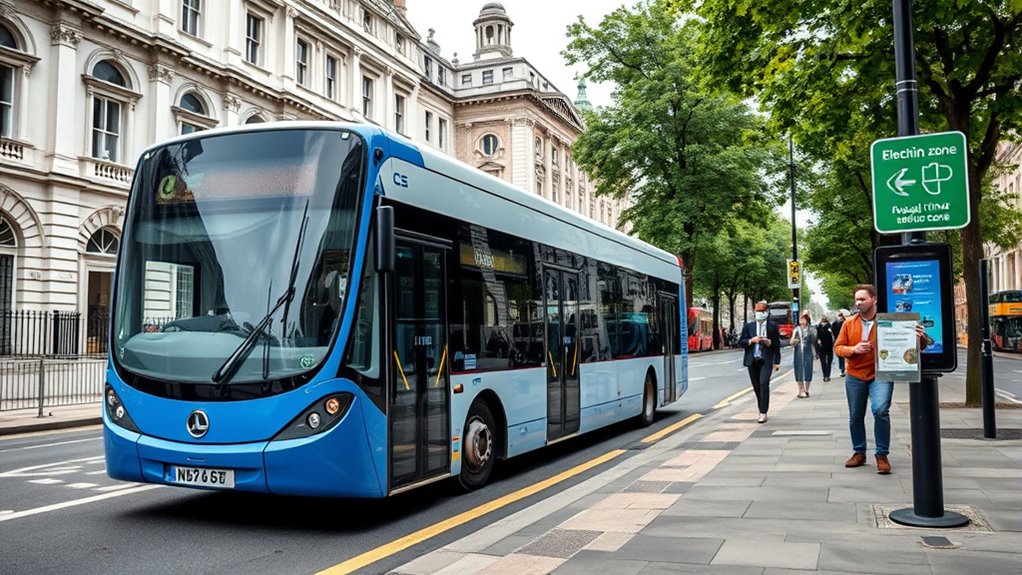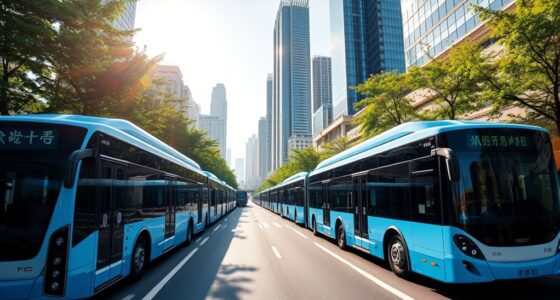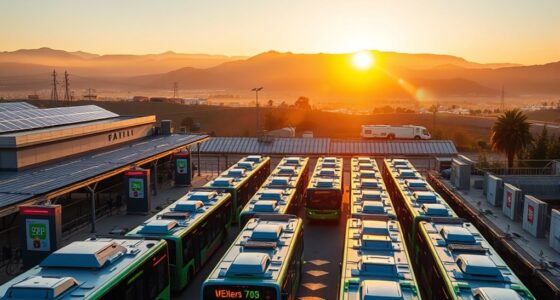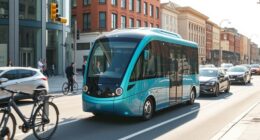London’s Zero-Emission Bus Zones monitor air quality using advanced sensors that track reductions in pollutants like NO2 and particulate matter. These zones demonstrate clear improvements, especially during peak hours, showing a strong positive impact on local air quality. The city invests heavily in infrastructure and uses real-time data for transparency and accountability. To understand how these measures are shaping London’s cleaner future, keep exploring how monitoring technologies are supporting sustainable transport goals.
Key Takeaways
- Sensors track air quality within and around bus zones to measure reductions in NO2 and particulate matter.
- Real-time data analytics evaluate pollution level changes during peak and off-peak hours.
- Monitoring results demonstrate tangible environmental benefits of transitioning to electric bus fleets.
- Data transparency ensures accountability and informs policy adjustments for improved air quality.
- Continuous monitoring supports London’s sustainability goals and showcases leadership in urban air pollution reduction.
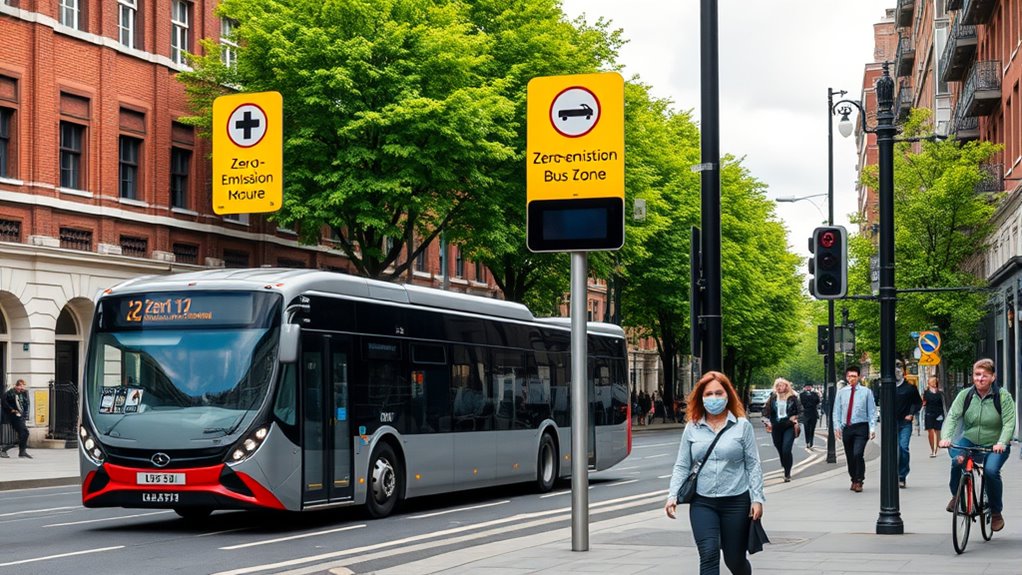
London is taking bold steps to clean up its transportation by establishing zero-emission bus zones across the city. These zones are designed to reduce air pollution and improve air quality in some of the busiest areas. Central to this effort is electric bus deployment, which replaces traditional diesel-powered buses with cleaner, more efficient electric alternatives. As you observe the city’s streets transforming, you’ll notice that electric buses are becoming a common sight, quietly gliding through neighborhoods and reducing emissions considerably.
The success of zero-emission bus zones hinges on substantial infrastructure investment. This means building the charging stations and electrical systems needed to support a growing fleet of electric buses. You’ll see rapid progress as the city allocates funds to expand charging infrastructure, making it easier for electric buses to operate reliably throughout the day. This infrastructure investment guarantees that buses can quickly recharge during short layovers, maintaining schedule efficiency while minimizing downtime. With more charging points strategically placed along routes, electric bus deployment becomes seamless, encouraging transit agencies to accelerate their transition away from fossil fuels.
Monitoring air pollution reductions in these zones offers concrete evidence of their impact. You can expect to see continuous air quality measurements showing drops in nitrogen dioxide (NO2) and particulate matter (PM), pollutants closely linked to diesel bus emissions. Data collected from sensors placed within and around these zones highlight notable improvements, especially during peak hours when diesel buses previously contributed to high pollution levels. These reductions not only benefit the environment but also enhance public health by lowering respiratory and cardiovascular risks for residents and commuters.
As you travel through London’s zero-emission bus zones, you’ll notice a cleaner, quieter environment. The deployment of electric buses contributes directly to cleaner air, but the ongoing monitoring guarantees transparency and accountability for the city’s efforts. This data helps policymakers and stakeholders evaluate the effectiveness of the initiative and make necessary adjustments. Additionally, the integration of advanced sensor technology and data analytics allows for more precise air quality monitoring, providing real-time insights into pollution levels and further supporting the city’s sustainability goals. The combination of electric bus deployment and targeted infrastructure investment demonstrates London’s commitment to sustainable transportation. It’s a proactive approach that sets a precedent for other cities aiming to cut pollution and combat climate change.
Ultimately, these measures are transforming London’s transportation landscape. By prioritizing zero-emission zones, investments in infrastructure, and the deployment of electric buses, the city is making measurable progress in reducing air pollution. As a resident or visitor, you benefit from healthier air and a quieter, more sustainable urban environment. Monitoring the results affirms that these actions are working, paving the way for a cleaner, greener future for London.
Frequently Asked Questions
How Are Air Quality Improvements Measured in Zero-Emission Zones?
You measure air quality improvements in zero-emission zones by using air quality sensors that track pollution metrics like nitrogen dioxide and particulate matter levels. These sensors provide real-time data, allowing you to compare pollution levels before and after zone implementation. By analyzing this data, you can determine the reduction in air pollutants, giving clear evidence of how zero-emission buses help improve air quality in those areas.
What Challenges Do Operators Face When Transitioning to Zero-Emission Buses?
You might think shifting is straightforward, but infrastructure challenges and workforce training pose real hurdles. You’ll need to invest in charging stations and upgrade existing facilities, which can be costly and complex. Additionally, your staff requires specialized training to operate and maintain zero-emission buses properly. Overcoming these issues demands careful planning, resources, and time, but the environmental and health benefits make the effort worthwhile.
Are There Plans to Expand Zero-Emission Zones Across All London Boroughs?
Yes, there are plans to expand zero-emission zones across all London boroughs. You should explore funding opportunities to support this shift, as they can help cover costs like fleet maintenance and infrastructure upgrades. By securing these funds, you’ll make it easier to implement zero-emission buses citywide, reducing pollution and improving air quality. The expansion aims to create a cleaner, healthier environment for everyone in London.
How Do Zero-Emission Zones Impact Public Transportation Costs?
Imagine riding a cleaner, quieter bus through your neighborhood—zero-emission zones can lower public transportation costs over time. They often lead to a positive cost analysis by reducing fuel and maintenance expenses. Funding opportunities from government grants or green investments help cover initial setup costs. While upfront costs may rise, daily operational savings and environmental benefits make these zones a financially smart choice for long-term transit improvements.
What Incentives Exist for Bus Operators to Adopt Zero-Emission Technology?
You’re encouraged to adopt zero-emission technology through government subsidies, which help offset the costs of fleet modernization. These incentives make it financially easier for bus operators to upgrade to cleaner, more sustainable buses. Additionally, government policies often prioritize zero-emission vehicles, providing benefits like preferential treatment or access to low-emission zones, further motivating you to modernize your fleet and contribute to improved air quality.
Conclusion
By embracing London’s zero-emission bus zones, you’re steering toward cleaner air and a healthier city. These zones act like a gust of fresh air, proving that small changes can create a big impact. As you see pollution levels drop, remember that your support helps drive this transformation. Together, you’re paving the road to a greener future, turning London’s air from a foggy memory into a clear, bright horizon.
